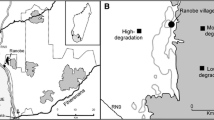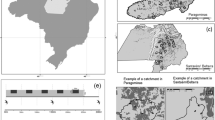Abstract
Common species can be major drivers of species richness patterns and make major contributions to biomass and ecosystem function, and thus should be important targets for conservation efforts. However, it is unclear how common species respond to disturbance, because the underlying reasons for their commonness may buffer or amplify their responses to disturbance. To assess how well common species reflect changes in their community (and thus function as indicator species), we studied 58 bird species in 19 mixed conifer patches in northern British Columbia, Canada, between 1998 and 2010. During this time period two disturbance events occurred, stand level timber harvest and a regional-scale bark beetle outbreak. We examined relationships among densities of individual species, total bird density and overall species richness, correlations in abundance among species, and responses to disturbance events. We found three broad patterns. First, densities of common species corresponded more strongly with changes in total bird density and overall species richness than rare species. These patterns were non-linear and species with intermediate-high commonness showed similar or better correspondence than the most common species. Second, common species tended to be more strongly correlated with abundances of all other species in the community than less-common species, although on average correlations among species were weak. Third, ecological traits (foraging guild, migratory status) were better predictors of responses to disturbance than species commonness. These results suggest that common species can collectively be used to reflect changes in the overall community, but that whenever possible monitoring programs should be extended to include species of intermediate-high commonness and representatives from different ecological guilds.




Similar content being viewed by others
References
Amici V, Battisti C (2009) Selecting focal species in ecological network planning following an expert-based approach: a case study and a conceptual framework. Landscape Res 34:545–561
Azeria ET, Fortin D, Hébert C, Peres-Neto P, Pothier D, Ruel J-C (2009) Using null model analysis of species co-occurrences to deconstruct biodiversity patterns and select indicator species. Divers Distrib 15:958–971
Bakker JD (2008) Increasing the utility of indicator species analysis. J Appl Ecol 45:1829–1835
Bates D, Maechler M (2010) lme4: Linear mixed-effects models using S4 classes. R package version 0.999375-35
Bentz BJ, Régnière J, Fettig CJ, Hansen EM, Hayes JL, Hicke JA, Kelsey RG, Negrón JF, Seybold SJ (2010) Climate change and bark beetles of the Western United States and Canada: direct and indirect effects. Bioscience 60:602–613
Burnham KP, Anderson DR (1998) Model selection and multimodel inference: a practical information-theoretic approach. Springer-Verlag, New York
Carignan V, Villard M-A (2002) Selecting indicator species to monitor ecological integrity: a review. Environ Monit Assess 78:45–61
Coops NC, Wulder MA (2010) Estimating the reduction in gross primary production due to mountain pine beetle infestation using satellite observations. Int J Remote Sens 31:2129–2138
Davies KF, Margules CR, Lawrence JF (2000) Which traits of species predict population declines in experimental forest fragments? Ecology 81:1450–1461
De’ath G, Fabricius KE (2000) Classification and regression trees: a powerful yet simple technique for ecological data analysis. Ecology 81:3178–3192
Drever MC, Martin K (2010) Response of woodpeckers to changes in forest health and harvest: implications for conservation of avian biodiversity. Forest Ecol Manag 259:958–966
Drever MC, Aitken KEH, Norris AR, Martin K (2008) Woodpeckers as reliable indicators of bird richness, forest health and harvest. Biol Conserv 141:624–634
Drever MC, Goheen JR, Martin K (2009) Species-energy theory, pulsed resources, and regulation of avian richness during a mountain pine beetle outbreak. Ecology 90:1095–1105
Edworthy AB, Drever MC, Martin K (2011) Woodpeckers increase in abundance but maintain fecundity in response to an outbreak of mountain pine bark beetles. Forest Ecol Manag 261:203–210
Evans KL, Greenwood JJD, Gaston KJ (2005) Relative contribution of abundant and rare species to species-energy relationships. Biol Lett 1:87–90
Gaston KJ (2008) Biodiversity and extinction: the importance of being common. Prog Phys Geog 32:73–79
Gaston KJ, Fuller RA (2008) Commonness, population depletion and conservation biology. Trends Ecol Evol 23:14–19
Githiru M, Lens L, Bennun LA, Matthysen E (2007) Can a common bird species be used as a surrogate to draw insights for the conservation of a rare species? a case study from the fragmented Taita Hills, Kenya. Oryx 41:239–246
Gotelli NJ, Colwell RK (2001) Quantifying biodiversity: procedures and pitfalls in the measurement and comparison of species richness. Ecol Lett 4:379–391
Gregory RD, Gaston KJ (2000) Explanations of commonness and rarity in British breeding birds: separating resource use and resource availability. Oikos 88:515–526
Houlahan JE, Currie DJ, Cottenie K, Cumming GS, Ernest SKM, Findlay CS, Fuhlendorf SD, Gaedke U, Legendre P, Magnuson JJ, McArdle BH, Muldavin EH, Noble D, Russell R, Stevens RD, Willis TJ, Woiwod IP, Wondzell SM (2007) Compensatory dynamics are rare in natural ecological communities. Proc Natl Acad Sci USA 104:3273–3277
Jetz W, Rahbek C (2002) Geographic range size and determinants of avian species richness. Science 297:1548–1551
La Sorte FA, Boecklen WJ (2005) Temporal turnover of common species in avian assemblages in North America. J Biogeogr 32:1151–1160
Lambeck RJ (1997) Focal species: a multi-species umbrella for nature conservation. Conserv Biol 11:849–856
Lawler JJ, White D, Sifneos JC, Master LL (2003) Rare species and the use of indicator groups for conservation planning. Conserv Biol 17:875–882
Lennon JJ, Koleff P, Greenwood JJD, Gaston KJ (2004) Contribution of rarity and commonness to patterns of species richness. Ecol Lett 7:81–87
Lindenmayer DB (1999) Future directions for biodiversity conservation in managed forests: indicator species, impact studies and monitoring programs. Forest Ecol Manag 115:277–287
Lindenmayer DB, Fischer J (2003) Sound science or social hook—a response to Brooker’s application of the focal species approach. Landscape Urban Plan 62:149–158
Lindenmayer DB, Franklin JF (2002) Conserving forest biodiversity a comprehensive multiscaled approach. Island Press, Washington
Lindenmayer DB, Margules CR, Botkin DB (2000) Indicators of biodiversity for ecologically sustainable forest management. Conserv Biol 14:941–950
Mahon CL, Steventon JD, Martin K (2008) Cavity and bark nesting bird response to partial cutting in Northern Conifer forests. Forest Ecol Manag 256:2145–2153
Mattfeldt SD, Bailey LL, Grant EHC (2009) Monitoring multiple species: estimating state variables and exploring the efficacy of a monitoring program. Biol Conserv 142:720–737
Mazaris AD, Kallimanis AS, Tzanopoulos J, Sgardelis SP, Pantis JD (2010) Can we predict the number of plant species from the richness of a few common genera, families or orders? J Appl Ecol 47:622–670
Münzbergová Z (2005) Determinants of species rarity: population growth rates of species sharing the same habitat. Am J Bot 92:1987–1994
Nielsen SE, Haughland DL, Bayne E, Schieck J (2009) Capacity of large-scale, long-term biodiversity monitoring programmes to detect trends in species prevalence. Biodivers Conserv 18:2961–2978
Niemi GJ, Hanowski JM, Lima AR, Nicholls T, Weiland N (1997) A critical analysis on the use of indicator species in management. J Wild Manage 61:1240–1252
Norris AR, Martin K (2010) The perils of plasticity: dual resource pulses increase facilitation but destabilize populations of small-bodied cavity-nesters. Oikos 119:1126–1135
Oksanen J, Blanchet FG, Kindt R, Legendre P, O’Hara RB, Simpson GL, Solymos P, Stevens MHH, Wagner H (2010) Vegan: Community ecology Package. R package version 1.17-4
Orme CDL, Davies RG, Burgess M, Eigenbrod F, Pickup N, Olson VA, Webster AJ, Ding T-S, Rasmussen PC, Ridgely RS, Stattersfield AJ, Bennett PM, Blackburn TM, Gaston KJ, Owens IPF (2005) Global hotspots of species richness are not congruent with endemism or threat. Nature 436:1016–1019
Padoa-Schioppa E, Baietto M, Massa R, Bottoni L (2006) Bird communities as bioindicators: the focal species concept in agricultural landscapes. Ecol Indic 6:83–93
Paine TD, Raffa KF, Harrington TC (1997) Interactions among scolytid bark beetles, their associated fungi, and live host conifers. Annu Rev Entomol 42:179–206
Pautasso M, Gaston KJ (2005) Resources and global avian assemblage structure in forests. Ecol Lett 8:282–289
Pearman PB, Weber D (2007) Common species determine richness patterns in biodiversity indicator taxa. Biol Conserv 138:109–119
R Development Core Team (2010) R: A language and environment for statistical computing, Version 2.11.1. R Foundation for Statistical Computing, Vienna
Robinson GR, Quinn JF (1988) Extinction, turnover and species diversity in an experimentally fragmented California annual grassland. Oecologia 76:71–82
Sizling AL, Sizlingova E, Storch D, Reif J, Gaston KJ (2009) Rarity, commonness and the contribution of individual species to species richness patterns. Am Nat 174:82–93
Sundt P (2002) The statistical power of rangeland monitoring data. Rangelands 24:16–20
Therneau TM, Atkinson B, Ripley B, Oksanen J, De’ath G (2010) mvpart: Multivariate partitioning. R package version 1.3-1
Zuur AF, Ieno EN, Walker NJ, Saveliev AA, Smith GM (2009) Mixed effects models and extensions in Ecology with R. Springer Books, New York
Acknowledgments
Thanks to A. Norris for discussions on study design, to A. Adams and H. Kenyon for assistance with data entry and interpretation, and all field workers over the years that assisted with data collection. K. Martin received financial support from Sustainable Forest Management Network, Forest Renewal BC, FIA Forest Sciences Program of BC, Environment Canada, and the Natural Sciences and Engineering Research Council of Canada (NSERC) Strategic Special Project. Tolko Industries Limited (Cariboo Woodlands) provided logistical and financial support from 1996 to 2003.
Author information
Authors and Affiliations
Corresponding author
Appendices
Appendix 1
See Table 1.
Appendix 2
The results of the models examining species responses to harvesting and MPB are outlined in Table 2, which is best explained using some examples. The second row of data is for the western wood-pewee (WWPE). Of the five models for this species the harvest model had the lowest QAICc value, and therefore the best explanatory power, as evidenced by the zero in the harvest column. The + indicates that harvesting had a positive effect on WWPE density. The QAICc value of the WWPE harvest model is at least two units less than the next simplest model, the null model (ΔQAICc = 20.8 − 0 = 20.8), so the text is bolded to indicate the strong support for an effect of harvesting. The pine model is also bolded, indicating that the QAICc value of this model is at least two units less than the next simplest model, the null model (ΔQAICc = 20.8 − 11.4 = 9.4). The + sign for the WWPE pine model is in brackets, indicating that the model-averaged coefficient for pine was positive but that the model that only included pine (i.e. not MPB or harvest) had a negative coefficient. The WWPE MPB model is also bolded, indicating strong support for an effect of MPB (ΔQAICc = 11.4 − 8.7 = 2.7). The MPB-harvest model has a low ΔQAICc value, comparable to the harvest model which is the best model overall. However the MPB-harvest ΔQAICc value is not bolded, indicating only weak support for this model. While the MPB-harvest model is better than the MPB model (ΔQAICc = 8.7 − 0.1 = 8.6), it is not better than the harvest model (ΔQAICc = 0 − 0.1 = − 0.1). This result means that while MPB was found to have an effect when considered on its own, the effect of MPB was relatively weak when harvesting was taken into account.
Our second example is for the Dusky or Hammond’s flycatcher (DUHA). Of the five models for this species the harvest model had the lowest ΔQAICc value, and therefore the best explanatory power, as evidenced by the zero in the harvest column. However, the zero is not bolded indicating there was only weak support for an effect of harvesting (ΔQAICc = 0.5 − 0 = 0.5). Similarly there was no support for an effect of pine or MPB on DUHA as these models have QAICc values greater than the null model.
Rights and permissions
About this article
Cite this article
Koch, A.J., Drever, M.C. & Martin, K. The efficacy of common species as indicators: avian responses to disturbance in British Columbia, Canada. Biodivers Conserv 20, 3555–3575 (2011). https://doi.org/10.1007/s10531-011-0148-3
Received:
Accepted:
Published:
Issue Date:
DOI: https://doi.org/10.1007/s10531-011-0148-3




